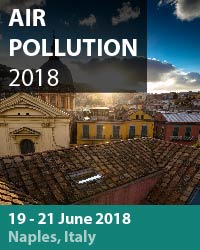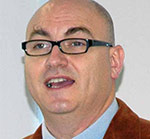Air Pollution 2018
26th International Conference on Modelling, Monitoring and Management of Air Pollution
![]()
19 - 21 June 2018
Naples, Italy
Overview

The 26th International Conference on Modelling, Monitoring and Management of Air Pollution took place in Naples, Italy, organised by Wessex Institute, represented by Professors Giorgio Passerini, Juan Casares Long and Giovanni Perillo, and University of the West of England, represented by Prof James Longhurst and Dr Joanna Barnes.
The meeting was sponsored by WIT Transactions on Ecology and the Environment, and the International Journal of Environmental Impacts.
Situated in the southern Italian region of Campania, Naples is one of Italy’s oldest and most important cities. The birthplace of some of Italy’s most iconic food and drink, good restaurants and cafés are plentiful in Naples, serving fresh local seafood and regional specialities. The historic centre is recognised as a UNESCO World Heritage site and offers a wealth of interesting architecture, monumental castles and museums, as well as galleries exhibiting works by some of Italy’s most distinguished artists. The surrounding area and coastline provide picturesque views of Capri and numerous small islands, while nearby Mount Vesuvius and the Roman remains of Pompeii and Herculaneum remain some of the most notable sites in southern Italy.
The conference took place in Villa Doria D’Angri, the most important neoclassical villa in the famous district of Posillipo. It was commissioned by Prince Marcantonio Doria d'Angri (1809-1837), a leading exponent of the family of Genoese origins. The work, through the design and supervision of the architect Bartolomeo Grasso, was completed in 1833. The view of the Gulf from the windows of Villa Doria d'Angri is so beautiful that Wagner, admiring it as a guest in 1880, eventually was inspired to compose the Parsifal, one of the most important musical masterpieces of all time. Wagner came to Naples with the royal train of Ludwig of Bavaria, was a guest at the villa for eight months, completed the Parsifal, and wrote the autobiographical book "My life". On the patio facing the “Salone” of the Villa, on 22 May 1880, the great Joseph Rubinstein premiered at the piano the music that accompanies the stage metamorphosis of the 1st act of Parsifal while everyone enjoyed the magnificent panorama at sunset from the Villa. Since then, the room where Wagner stayed has been called the "Wagner Room". It is today one of the buildings of the University “La Parthenope” and hosts a part of the Museum of the old Naval School of Naples.
Opening of the Conference
The conference was opened by Prof Giorgio Passerini and Prof Juan Casares Long, Directors of WIT, who firstly paid tribute to the founder of the Wessex Institute, the late Prof Carlos Brebbia. Carlos was a gifted academic, renowned throughout the world as the originator of the Boundary Element Method, a tool now widely used for practical engineering analysis. Recent developments at the Institute continue to expand its range of applications to a myriad of problems of interest to engineering practitioners. The dissemination of scientific and technical information is one of the primary functions of WIT, together with the continuous research and development of advanced computational tools.
Giorgio explained the function of WIT that has organised, amongst other activities, this International Conference for a quarter of a century, bringing to the attention of the community the latest developments in air pollution research. This wealth of information is available in the digital library of the Institute (https://www.witpress.com/elibrary) where all air pollution papers can be freely downloaded.
Keynote Address
The keynote address was given by Prof James Longhurst entitled “Analysing Air Pollution and its Management through the Lens of the Unsustainable Development Goals. A Review and Assessment”.
This address provided a high-level assessment of the causes and impacts of air pollution and its management through the lens of the United Nations Sustainable Development Goals (SDGs). Through a literature review and expert assessment process, the impact of air pollution as a barrier to achieving the SDGs was considered. The enabling contribution of air quality management was also assessed. The assessment considered the individual goal level as well as providing a synoptic overview of the 17 interconnected goals. The issues of air quality, air pollution and its management were not clearly identified in any of the 17 headline goals but to varying degrees were directly or indirectly present in some of the underpinning targets or indicators within the SDG framework. Air pollution was identified in this assessment as a direct enabler for each of the individual goals whilst air quality management was assessed as an enabler for 9 goals and provided co-benefits for the other 8. The importance of addressing air pollution as a negative constraint on sustainable progress was of fundamental importance, but the positive enabling contributions of the clean air to the meeting of SDGs must also be recognised.
Special Session
A special session was organised by Prof Enda Hayes from the University of the West of England, UK on the subject of improving air quality and reducing carbon footprint in cities: a focus on citizens. This included the following papers:
- Claircity project: Citizen-led scenarios to improve air quality in European cities.
- “Unfortunately I use a car”: Commuter transport choices in Bristol, UK.
- Air pollution in Aveiro Region: a citizen’s engagement approach.
- Air pollutants emission inventory and carbon footprint at city level in the project ClairCity
Invited Speakers
The conference was further enhanced by a series of invited presentations:
- “Qualitative assessment of links between exposure to noise and air pollution, and socioeconomic status”, by Jo Barnes, University of the West of England, UK.
- “Ozone episodes over the southeast Iberian coast: origin and recycling between two seas”, by Juan Casares, University of Santiago of Compostela, Spain.
- “Study of air contamination by heavy metals on firing ranges”, by Karel Lach, Institute of Public Health, Czech Republic.
- “Climate change mitigation: analysis and hypothesis of interventions”, by Elena Magaril, Ural Federal University, Russia.
- “Temporal change of indoor-VOC composition – consequences for human health risk assessment”, by Olf Herbarth, University of Leipzig, Germany.
- “Towards a sustainable management of air quality and human exposure: Examplary case studies”, by Marco Schiavon, University of Trento, Italy.
- “Influence of boundary layer schemes in modelling the dispersion and sedimentation of volcanic ash in Ecuador”, by Rene Parra, University San Francisco of Quito, Ecuador.
- “Analysis of air pollutants emission in a wastewater treatment plant by means of dispersion models”, by Giorgio Passerini, Marche Polytechnic University, Italy.
- “Indoor air pollution: BTEX in occupational environment”, by Israel Felzenszwalb, State University of Rio de Janeiro, Brazil.
Session Topics
The papers were divided into a series of sessions under the following headings:
- Aerosols and Particles
- Emission Studies
- Monitoring and Measuring
- Air Pollution Modelling
- Air Data Quality
- Health Effects
- Air Pollution Control Technologies
Conference Breaks and Dinner
The delegates had many occasions for interacting and discussing problems of common interest during the coffee breaks, lunches and social occasions, as well as during the formal sessions. It was incredible that the delegates had coffee breaks and lunches in the same “Salone” and on the same patio where Wagner and Rubinstein shaped the History of Melodrama.
The International Scientific Advisory Committee (ISAC) met over dinner to discuss how to improve the meeting. Different topics of current interest were put forward as well as nominations for new members of the Committee. The success of the conference is due to its continuous evolution. Several locations for the 2020 meeting were discussed (the 2019 conference will be held in Aveiro, Portugal).
The Conference Banquet took place at “La Scialuppa” (the Jolly-Boat) within the wonderful “Borgo Marinaro”, the oldest maritime village of Naples located near Castel dell’Ovo. The guests enjoyed freshly caught fish, mussels and the famous “Greco di Tufo” white wine while listening to the most beautiful songs of the Naples’ tradition. A special song was dedicated to the Memory of the late Prof Carlos Brebbia.
Closing of the Conference
The Conference was closed by Giorgio Passerini and Juan Casares Long who thanked the delegates for their contribution to the success of the meeting. The next conference will take place in Aveiro, Portugal from 26-28 June 2019.
Related Conferences
Sustainable Development and Planning 2018, 4 - 6 September 2018
Energy Quest 2018, 10 - 12 September 2018
Urban Transport 2018, 19 - 21 September 2018
Urban Transport 2019, 25 – 27 June 2019
Air Pollution 2019, 26 – 28 June 2019
Energy and Sustainability 2019, 3 - 5 July 2019
Disaster Management 2019, 25 – 27 September 2019




 Wessex Institute
Wessex Institute